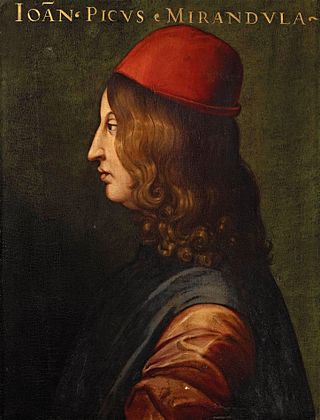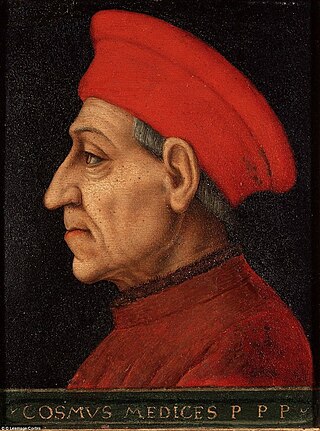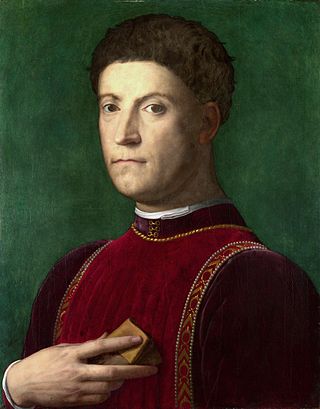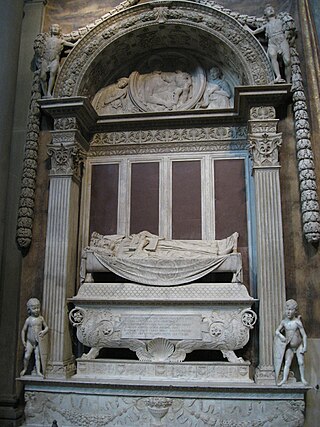Related Research Articles

Lorenzo di Piero de' Medici, known as Lorenzo the Magnificent, was an Italian statesman, the de facto ruler of the Florentine Republic, and the most powerful patron of Renaissance culture in Italy. Lorenzo held the balance of power within the Italic League, an alliance of states that stabilized political conditions on the Italian Peninsula for decades, and his life coincided with the mature phase of the Italian Renaissance and the golden age of Florence. As a patron, he is best known for his sponsorship of artists such as Botticelli and Michelangelo. On the foreign policy front, Lorenzo manifested a clear plan to stem the territorial ambitions of Pope Sixtus IV, in the name of the balance of the Italic League of 1454. For these reasons, Lorenzo was the subject of the Pazzi conspiracy (1478), in which his brother Giuliano was assassinated. The Peace of Lodi of 1454 that he supported among the various Italian states collapsed with his death. He is buried in the Medici Chapel in Florence.

Marsilio Ficino was an Italian scholar and Catholic priest who was one of the most influential humanist philosophers of the early Italian Renaissance. He was an astrologer, a reviver of Neoplatonism in touch with the major academics of his day, and the first translator of Plato's complete extant works into Latin. His Florentine Academy, an attempt to revive Plato's Academy, influenced the direction and tenor of the Italian Renaissance and the development of European philosophy.

Girolamo Savonarola, OP or Jerome Savonarola was an ascetic Dominican friar from Ferrara and a preacher active in Renaissance Florence. He became known for his prophecies of civic glory, his advocacy of the destruction of secular art and culture, and his calls for Christian renewal. He denounced clerical corruption, despotic rule, and the exploitation of the poor.

Giovanni Pico dei conti della Mirandola e della Concordia, known as Pico della Mirandola, was an Italian Renaissance nobleman and philosopher. He is famed for the events of 1486, when, at the age of 23, he proposed to defend 900 theses on religion, philosophy, natural philosophy, and magic against all comers, for which he wrote the Oration on the Dignity of Man, which has been called the "Manifesto of the Renaissance", and a key text of Renaissance humanism and of what has been called the "Hermetic Reformation". He was the founder of the tradition of Christian Kabbalah, a key tenet of early modern Western esotericism. The 900 Theses was the first printed book to be universally banned by the Church. Pico is sometimes seen as a proto-Protestant, because his 900 theses anticipated many Protestant views.

Filippino Lippi was an Italian painter working in Florence, Italy during the later years of the Early Renaissance and first few years of the High Renaissance.

Cosimo di Giovanni de' Medici was an Italian banker and politician who established the Medici family as effective rulers of Florence during much of the Italian Renaissance. His power derived from his wealth as a banker and intermarriage with other rich and powerful families. He was a patron of arts, learning, and architecture. He spent over 600,000 gold florins on art and culture, including Donatello's David, the first freestanding nude male sculpture since antiquity.

Piero di Lorenzo de' Medici, called Piero the Fatuous or Piero the Unfortunate, was the lord of Florence from 1492 until his exile in 1494.

Piero di Cosimo de' Medici, known as Piero the Gouty, was the de facto ruler of Florence from 1464 to 1469, during the Italian Renaissance.

Lorenzo di Pierfrancesco de' Medici, nicknamed the Popolano, was an Italian banker and politician, the brother of Giovanni il Popolano. He belonged to the junior branch of the House of Medici of Florence.

Demetrios Chalkokondyles, Latinized as Demetrius Chalcocondyles and found variously as Demetricocondyles, Chalcocondylas or Chalcondyles was one of the most eminent Greek scholars in the West. He taught in Italy for over forty years; his colleagues included Marsilio Ficino, Poliziano, and Theodorus Gaza in the revival of letters in the Western world, and Chalkokondyles was the last of the Greek humanists who taught Greek literature at the great universities of the Italian Renaissance. One of his pupils at Florence was the famous Johann Reuchlin. Chalkokondyles published the first printed publications of Homer, of Isocrates, and of the Suda lexicon.

AgnoloAmbrogini, commonly known as Angelo Poliziano or simply Poliziano, anglicized as Politian, was an Italian classical scholar and poet of the Florentine Renaissance. His scholarship was instrumental in the divergence of Renaissance Latin from medieval norms and for developments in philology. His nickname Poliziano, by which he is chiefly identified to the present day, was derived from the Latin name of his birthplace, Montepulciano.

Filippo Lippi, also known as Lippo Lippi, was an Italian painter of the Quattrocento and a Carmelite priest. He was an early Renaissance master of a painting workshop, who taught many painters. Sandro Botticelli and Francesco di Pesello were among his most distinguished pupils. His son, Filippino Lippi, also studied under him and assisted in some late works.

Lorenzo Lippi was an Italian painter and poet from Florence.

Giovanni de' Medici, in full Giovanni di Pierfrancesco de' Medici, later known as il Popolano was an Italian nobleman of the Medici House of Florence. He was the son of Pierfrancesco di Lorenzo de' Medici, and therefore a member of a secondary branch of the family.

Carlo Marsuppini (1399–1453), also known as Carlo Aretino and Carolus Arretinus, was an Italian Renaissance humanist and chancellor of the Florentine Republic.
Platonism, especially in its Neoplatonist form, underwent a revival in the Renaissance as part of a general revival of interest in classical antiquity. Interest in Platonism was especially strong in Florence under the Medici.
The Platonic Academy of Florence was an informal discussion group which formed around Marsilio Ficino in the Florentine Renaissance of the fifteenth century.

The Florentine Renaissance in art is the new approach to art and culture in Florence during the period from approximately the beginning of the 15th century to the end of the 16th. This new figurative language was linked to a new way of thinking about humankind and the world around it, based on the local culture and humanism already highlighted in the 14th century by Petrarch and Coluccio Salutati, among others. Filippo Brunelleschi, Donatello and Masaccio's innovations in the figurative arts at the very beginning of the 15th century were not immediately accepted by the community, and for some twenty years remained misunderstood and in the minority compared to International Gothic.

Giovanni Nesi (1456–1506) was a Florentine philosopher of the Renaissance.
References
- ↑ M Jurdjevic ISBN 0191607096 [Retrieved 2015-3-21]
- ↑ M Jurdjevic shown in Lorenzo de' Medici: Oxford Bibliographies Online Research Guide p.8 [Retrieved 2015-3-21]
- ↑ The Drawings of Filippino Lippi and His Circle (p.13) edited by GR. Goldner, C Bambach [Retrieved 2015-3-21]
- ↑ Jill Burke - Changing Patrons: Social Identity and the Visual Arts in Renaissance Florence (p.155) [Retrieved 2015-3-21] (ed. identified <Valori Chapel>)
- ↑ Raffaello Borghini (c.1584)- Il Riposo (p.169) University of Toronto Press, 2007 [Retrieved 2015-3-21]
- ↑ J Kirshner - Marriage, Dowry, and Citizenship in Late Medieval and Renaissance Italy University of Toronto Press, 26 Feb 2015 ISBN 1442664525 [Retrieved 2015-3-21]
- ↑ M Jurdjevic - Guardians of Republicanism: The Valori Family in the Florentine Renaissance Oxford University Press, 6 Mar 2008 ISBN 0191607096 (214 pages) [Retrieved 2015-2-21]
- ↑ Paul Oskar Kristeller - Studies in Renaissance Thought and Letters, Volume 3 (p.145) Ed. di Storia e Letteratura, 1993 [Retrieved 2015-3-21]
- ↑ Oxford dictionaries - corpus [Retrieved 2015-3-21](ed. knows prior of this word via mention somewhere of Corpus Christi College, Oxford possibly,but first source is not known)
- 1 2 Lackner, D. F. (2002). Allen, M. J. B.; Rees, V.; Davies, M. (eds.). Marsilio Ficino: His Theology, His Philosophy, His Legacy. BRILL. ISBN 9004118551 . Retrieved 2015-03-21.
- ↑ Poggio in Notes and Queries (p.36) Oxford University Press, 1850 (Original from UC Southern Regional Library Facility, Digitized - 24 Jul 2014)[Retrieved 2015-3-21]
- 1 2 L Martines (21 Apr 2006). Fire in the City: Savonarola and the Struggle for the Soul of Renaissance Florence (p.238-9). Oxford University Press. ISBN 0199884307 . Retrieved 2015-03-21.
- 1 2 Tomas 2003, p. 109.
- ↑ RC Trexler shown on p.7 of Lorenzo de' Medici: Oxford Bibliographies Online Research Guide Oxford University Press, 1 Jun 2010 ISBN 0199809593 [Retrieved 2015-3-21]
- ↑ W Roscoe - The life and pontificate of Leo the tenth, 4th ed., revised by T. Roscoe (p.360) published 1846 [Retrieved 2015-3-21]